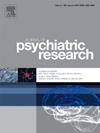Recognizing individual variability in misophonia: Identifying symptom-based subgroups with Gaussian mixture modeling
IF 3.7
2区 医学
Q1 PSYCHIATRY
引用次数: 0
Abstract
Misophonia is characterized by intense emotional and physiological reactions to everyday sounds such as chewing and tapping. While previous researchers have focused on defining and characterizing the disorder, limited attention has been given to the variability in symptom presentations across individuals. In this study, we sought to identify distinct subgroups of individuals with misophonia by applying a Gaussian finite mixture model to explore the heterogeneity of symptom profiles. Sixty treatment-seeking participants completed the Duke Misophonia Interview, which assessed the presence and severity of various behavioral, affective, and cognitive symptoms. Items from this measure served as model indicators. Two clusters were found: anticipatory and reactive. The anticipatory group reported heightened awareness of potential triggers, preemptive anticipatory distress, and increased avoidance behaviors, while the reactive group primarily displayed emotional and physiological responses during the occurrence of sounds. Notably, both groups reported similar frequencies of misophonic triggers, but the anticipatory group demonstrated greater internalizing symptoms, such as intrusive thoughts or rumination about misophonic sounds and social isolation. Our findings support the need for tailored interventions that address subgroup-specific symptom patterns. Future researchers should aim to include larger sample sizes and develop more comprehensive models to capture the full spectrum of misophonia symptoms, including externalizing behaviors.
求助全文
约1分钟内获得全文
求助全文
来源期刊

Journal of psychiatric research
医学-精神病学
CiteScore
7.30
自引率
2.10%
发文量
622
审稿时长
130 days
期刊介绍:
Founded in 1961 to report on the latest work in psychiatry and cognate disciplines, the Journal of Psychiatric Research is dedicated to innovative and timely studies of four important areas of research:
(1) clinical studies of all disciplines relating to psychiatric illness, as well as normal human behaviour, including biochemical, physiological, genetic, environmental, social, psychological and epidemiological factors;
(2) basic studies pertaining to psychiatry in such fields as neuropsychopharmacology, neuroendocrinology, electrophysiology, genetics, experimental psychology and epidemiology;
(3) the growing application of clinical laboratory techniques in psychiatry, including imagery and spectroscopy of the brain, molecular biology and computer sciences;
 求助内容:
求助内容: 应助结果提醒方式:
应助结果提醒方式:


